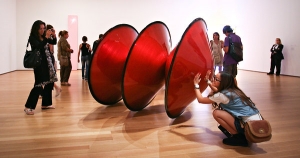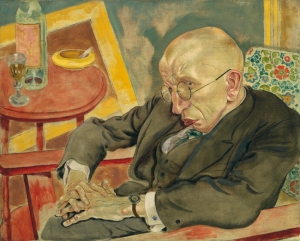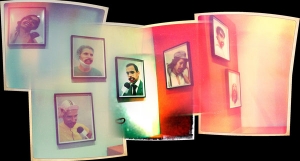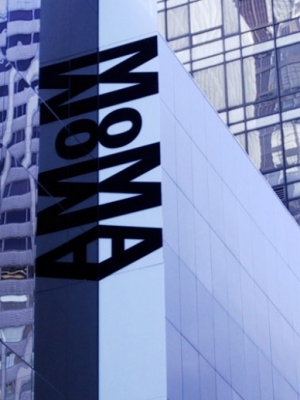|
Displaying items by tag: MOMA

At Progressive’s offices in Mayfield Village, Ohio, a walk down the stairs is a little more exciting than at most companies. The main stairwell is draped with candles, steel, wire, silk flowers and ribbons all dripped in wax. The installation, by artist Petah Coyne, gives the space the feel of a “haunted ballroom,” says Kristin Rogers, art education and communications manager for the Progressive Collection.
The auto insurance giant boasts one of the most extensive contemporary art collections in the corporate world, and it’s more than just decoration: the company says it uses the art to encourage its employees to think creatively.
Hundreds if not thousands of companies collect art—but only a few make an art of collecting.
Financial return is not the aim. “Art is a risky investment,” says Shirley Reiff Howarth, editor of the International Directory of Corporate Art, who points to the notion that there must be some financial payoff as one of the great myths that surround corporate art.
Some corporate collections are little more than furnishing, others are historical. The companies on our list of the top corporate art collections, however, fall under a third category of corporations that do more than just possess work. Nick Orchard, head of Corporate Collections at Christie’s Europe, calls this “proactive collecting.” UBS and Deutsche Bank, for example, have made art central to their corporate identities. Bank of America uses art to connect with the public.
To come up with our list of the best corporate art collections, we spoke to a range of writers, art advisers and curators. Their standard: the best collections use art to improve lives and to educate. In addition to expert interviews, we considered activity and buzz around the collection. This means owning fifty Picassos is not enough if they have been sitting in storage for a decade.
Some of the collections are managed by a staff of curators and others rely on outside advisers. Some are largely open the public and others are only accessible to employees. Collections that have been sold or donated to museums are not included and the corporation must currently maintain the collection to be considered for this list. None of the corporations we spoke with would disclose the value of their collection for this story.
One of the companies featured on our list is UBS, which owns 35,000 pieces of modern and contemporary art. The Swiss bank mainly acquires works by relatively unknown (aka less expensive) emerging and mid-career artists. UBS’ philosophy is “to be supporting living artists at integral stages of their career,” says Jacqueline Lewis, the bank’s curator for the Americas.
The bank has loaned or gifted some of its art to major museums like MOMA, but much of the collection is displayed in employee only areas. Works are rotated among UBS location every year or two. Lewis says she often gets frustrated calls from bank employees when a work they’ve grown attached to is moved.

Five weeks after protesters occupied a Lower Manhattan plaza to press for economic and political change, they’ve turned their attention to what they call “temples of cultural elitism,” New York’s museums.
Members of an offshoot of Occupy Wall Street calling itself Occupy Museums yesterday targeted the Museum of Modern Art and the New Museum of Contemporary Art.
They took turns reading from a statement, with the crowd repeating each line in a call-and-response system used at their Wall Street base in Zuccotti Park and in many protests.
“The Occupy Wall Street Movement will bring forth an era of new art, true experimentation outside the narrow parameters set by the market,” was the chant at one point, voiced by a crowd comprising a few dozen artists, students and passers-by outside MoMA.
Artist Dave Kearns complained about MoMA’s regular admission fee, calling $25 “an obscene amount of money,” and adding, “There should be more nights when it’s free.”
A person in a gorilla mask said he or she -- the gender wasn’t clear from the voice -- worked in a New York museum and didn’t care for its exclusionist curatorial choices.
A 34-year-old artist named Blithe Riley proposed that the group skip the Frick Collection, which was to be temple No. 2, and go directly to No. 3, the New Museum.
“Three museums might be a lot for one day,” she said.
Show of Hands
With a show of hands, the group indicated a consensus for her proposal.
“We’re going to occupy the New Museum now,” Riley said.
A couple exiting MoMA looked perplexed.
“I don’t know what they mean, ‘Occupy the New Museum?’” said Ruth Geisenheimer, 82, from Chicago.
“What do they intend to do with this museum?” asked her husband, Ed, 87.
Noah Fischer, a 34-year-old Brooklyn-based artist who devised Occupy Museums, said the group makes no demands.
“We want to use the democratic process to bring people together and learn what a society that is not about money is like,” he said in an interview.
Outside the New Museum, Fischer called it a “pyramid scheme of the 1 percent.”
“These artists are conflated with capital,” he said.
There are any number of ways to make a picture, a notion that Dan Leers, curator of this year’s New Photography show at the Museum of Modern Art wanted to address in the exhibition, which opens Sept. 28.
“This year, my hope was to give an idea of the different ways photography is practiced today. I think all of the artists bring a unique background—where they are from, their training and their style,” Leers says. “That, in turn, makes each artist’s work unique and different than everything else.”
The annual New Photography show in New York City has launched the careers of many photographers while documenting major shifts in the practice, process and direction in which the medium is headed. Since its inception in 1985—minus a hiatus between 1998 to 2004 during renovations to the museum—each year’s exhibition is representative of the institution’s voice on prominent emerging work within the contemporary art photography world.

The permanent collection of any great museum is in a state of constant, usually subtle flux. Works go up, are shifted about and later removed from view, making way for others. Often such changes pass all but unnoticed. But occasionally the adjustments are more pronounced and widespread, achieving a kind of critical mass and creating a different sense of the institution, its holdings and its possibilities.
Over the past few months changes of this kind have been unfolding in some of the most hallowed and closely watched galleries in the world: those that the Museum of Modern Art devotes to its unparalleled collection of painting and sculpture. The displays in many of these spaces, which occupy the museum’s fourth and fifth floors, have been rejiggered or completely rethought. Taken together they make for a fascinating museum experience — not without flaws, certainly, but charged with a promising spirit of inclusiveness and flexibility and dotted with unfamiliar works and juxtapositions.
These changes are largely the work of Ann Temkin, who arrived at the museum in 2003 and became chief curator of painting and sculpture in 2008, one of very few to hold the job. They constitute the strongest sign yet of her approach to the permanent collection and were accomplished in collaboration with five other curators: Anne Umland, Leah Dickerman and Laura Hoptman, also of the painting and sculpture department; Connie Butler, chief curator of drawings; and Christophe Cherix, chief curator of prints and illustrated books.
You might say that Ms. Temkin and her team are trying to help the Modern get over itself, to play down its role as anointer and definer and keeper of the canon, and to soften its historic focus on linearity, male genius and art movements (or at least strictly defined ones) while excavating exciting, little-seen treasure from deep storage. A very un-Modern-like phrase appears in wall texts at the start of both the fourth and fifth floors, telling us “there are countless ways to explore the history of modern art and the museum’s rich collection.”
The reinstallation is most thorough-going in the fourth-floor galleries, devoted to art since 1940. Here, at the end of April, Ms. Temkin was presented for the first time in her tenure with a clean slate: empty galleries that had to be installed from scratch following the close of “Abstract Expressionist New York: The Big Picture,” the seven-month blowout of Abstract Expressionist works from the Modern’s collection that she mounted last fall. It was a rare opportunity to do something different, and something different has been done.

When the Expressionist artist George Grosz, a celebrated painter, fled Nazi Germany in 1933, he left behind two important oil paintings and a watercolor with his Berlin dealer. Next month the United States Supreme Court, in deciding whether to hear the case, will determine whether Grosz’s heirs have any hope that legal action will help them recover the works from their current owner, the Museum of Modern Art.
The lawsuit is an emotional, last-ditch effort by Grosz’s son Martin, and Martin’s sister-in-law, Lilian, to reclaim works they say were lost in the midst of Nazi persecution, only to end up two decades later in one of the world’s most elite art institutions.
Beyond the family, the case has drawn the attention of Jewish groups and experts in international law who argue that the Grosz case, like many others concerning art looted or lost during World War II, have too often been decided not on the merits but on whether claimants filed suit before the legal time limit.
MoMA, for example, has won several lower court decisions in the Grosz case because judges have ruled that the family simply filed its suit too late to be considered under New York State law. The United States has twice signed international agreements that urged nations to decide Holocaust-recovery claims based on their substance, not on legal technicalities. But the agreements do not have the force of law.
“Museums are breaking their own ethics codes and causing the U.S. government to break its international commitments by invoking our courts to resolve Holocaust-era art claims on technical grounds rather than on the merits,” said Jennifer Anglim Kreder, co-chairwoman of the American Society of International Law’s Interest Group on Cultural Heritage & the Arts.
Ms. Kreder is an author of a “friends of the court” brief supporting the Groszes. Several other organizations have also weighed in to argue against the use of statutes of limitations to bar such claims. The organizations include the American Jewish Congress and the nonprofit Commission for Art Recovery.
The museum, which acquired the works in the 1950s, declined to comment because the case is being litigated. But it has maintained in court documents that, regardless of the timing issue, it has diligently researched the artworks’ provenance and has found no evidence that the works were looted by the Nazis or any basis for disputing their legitimate ownership.
Raymond J. Dowd, the Groszes’ lawyer, counters that the lower court considered inadmissible evidence and also failed to take into account a 1998 federal law that was intended to help Holocaust-era victims recover their assets.
Since 2004, the Supreme Court has refused to review several Nazi-era art cases, most recently in June when it decided not to review a case brought against the Norton Simon Museum in Pasadena, Calif., which ran afoul of a different deadline statute. Lawyers involved in Grosz v. Museum of Modern Art agree that it is unlikely that the high court, given its reluctance to weigh in on matters of state law, will take up this case when it meets on Sept. 26 to review the appeal.

Among the many things to marvel over in “Talk to Me,” a new exhibition at the Museum of Modern Art about how people and objects communicate, is a device called the “communication prosthesis.” It’s a rigid mouthpiece that stretches the lips wide, exposing the wearer’s teeth and gums. It forces timid people to look as aggressive and unhinged as Heath Ledger’s Joker in “The Dark Knight.”
As I stood before this device, it occurred to me that it was, to no small degree, a visual manifestation of the semantic landscape of Manhattan — a place where words are loud, large, strange, tinnitus-inducing, sometimes beautifully vulgar, straining to be heard. Language here has teeth; it seeks you out; it wants a piece of you.
I’m a book critic, a person who evaluates words for a living, and the city, surely, offers its own shifting types of poetry, worth pausing to observe and consider. So on a sunny day in July, I spent a day in Manhattan — along with my two kids, Penn and Harriet — in search of language on a smaller, more fugitive scale. We walked across the city and took subways and cabs, looking at everyday words: the language of street signs and menus, MetroCards and T-shirts. Our close attention was rewarded. This was a movable feast.
We planned our day around a few of our favorite things: breakfast at Barney Greengrass, the Old World smoked-fish and bialys emporium on the Upper West Side; a visit to MoMA; stops at the Forbidden Planet comics store and the venerable used-book market the Strand (providentially, these are on the same block); lunch in Chinatown; and finally a visit to Economy Candy, the dowdy sweets warehouse on the Lower East Side. If my kids, like my dogs, had tails, even a whispered mention of Economy Candy would make them knock over side tables.
My family recently moved to western New Jersey; a bus trip is a convenient way to reach New York City. The surprises began when, aboard our early-morning Trans-Bridge bus, we decided to read together, for the first time, the small print on the back of our ticket stubs. Here is the sentence we encountered, mandated by the United States Department of Transportation: “Seating aboard vehicles operated in interstate or foreign commerce is without regard to race, color, creed or national origin.”
Two thoughts leapt to mind. First, is this language necessary 56 years after Rosa Parks? Second, and more alarmingly, what if this bus were traveling between points in New Jersey — say, Princeton and Asbury Park — and not “interstate”? Would discrimination be tolerated? The ticket stub does not mention cellphone abusers. These people should always be exiled to the back of the bus, the despised place that Martin Amis has called — referring to airplanes — “toilet world.”
Barney Greengrass is a half-block from West 86th Street, part of which is also known as Isaac Bashevis Singer Boulevard. We stopped and stared at Singer’s street sign. My daughter, who is 12, recently became a vegetarian, and among the details I recalled of this lovely writer’s life is that he was a vegetarian as well.
“I did not become a vegetarian for my health,” Singer said. “I did it for the health of the chickens.”
On that street sign Singer’s name is spelled entirely in capital letters — in all-caps, as word people say. This turned out to be worth noticing. New York City is in the process of eliminating its all-caps street signs; they turn out to be less legible than those in upper- and lower-case. The New York Observer has called this sign-swapping project, due to be completed in 2018, a “$28 million copy edit.”
At Barney Greengrass, the pretentious food cretin in me, who likes to eat unusual things partly because of their names, was tempted by something called “Nova Scotia Heads and Wings Broiled With Onions.” (Thanks to the obsession with so-called nose-to-tail eating, I await a dish called, after an underpraised Elvis Costello song, “Pads, Paws and Claws.”) I had the scrambled eggs with sturgeon, an old and reliable friend.

New York’s Museum of Modern Art, which is raising adult admission 25 percent to $25, paid Director Glenn Lowry $1.6 million in 2009.
Though Lowry took a 14 percent compensation cut, he remained among the best paid museum directors. His salary and bonus totaled $830,000. He also received $403,635 in retirement and other deferred compensation, plus housing in the museum’s luxury condominium tower valued at $318,000, according to MoMA’s 2009-2010 tax return.
The admission increase from $20 goes into effect Sept. 1, a result of escalating costs, the museum announced last week.
Ellen Futter, who runs the American Museum of Natural History, earned $972,249 in salary and benefits in 2009, up 0.5 percent from a year earlier. The Metropolitan Museum of Art paid its new chief, Thomas Campbell, $929,735. In July, the Met raised its adult admission to $25, which, unlike MoMA’s, is “suggested.”
Both Futter and Campbell earned what amounts to 20 cents per visitor in 2009-2010, while Lowry earned more than 50 cents for every attendee. The Met and the Museum of Natural History are public institutions that sit on city-owned land and depend on government beneficence. By contrast, MoMA sits on private land and receives little government operating support.
Since being hired from Toronto’s Art Gallery of Ontario in 1995, Lowry has worked to double gallery space. He led an $858 million capital campaign that increased square footage for exhibitions by 40,000, to 125,000.

Last night, the American Folk Art Museum — that beloved, bedeviled museum on West 53rd Street — confirmed what many of us had feared for years. It is in such deep debt and has such low attendance numbers that it will sell its building and relocate back to a lobby space one sixth its current size near Lincoln Center. Sad as it is to say, this news comes as no surprise, and the culprit is the museum's physical home.
Despite the many rave reviews the 30,000-square-foot building received when it opened in December 2001, it was immediately clear to many that the building was not only ugly and confining, it was also all but useless for showing art — especially art as visionary as this museum's. In the past decade, AFAM has mounted shows of some of the greatest artists of the twentieth century, including Martin Ramirez, Henry Darger, Adolf Wolfli, and Thomas Chambers. Yet from the outside it looked like a bronzed Kleenex box or a miniature suburban professional building. The inside was worse. Dominated by showy staircases of many scales going in different directions, ill-conceived nooks and niches, the galleries were long narrow corridors or landings, sometimes only a few feet wide, making it impossible to see the art. The largest exhibition spaces had the look of a gloomy cloakroom. The architects responsible for this utter lack of imagination and hubristic mess of starchitectural vanity, Tod Williams and Billie Tsien, were praised for their intelligent use of materials. The building was called astonishing, a shrine, a temple, a Zen masterpiece. In reality, every one of their decisions reflected a total lack of feeling for, even a disdain for, art. Before he died, the Times architectural critic Herbert Muschamp, who'd said nice things about the building when it opened, confided to me that my loathing was “probably right.”

The Museum of Modern Art will be extending its hours from July 1 through September 3, keeping the museum open until 8:30 p.m. on Thursday, Friday, and Saturday (with the exception of Saturday, July 9) evenings, and opening its doors from 10:30 a.m. to 5:30 p.m. on Tuesdays (July 5 through August 30), a day the Museum is usually closed, providing the public with more opportunities to enjoy the Museum's renowned collection and special exhibitions. Also this summer, live music performances return to MoMA's Abby Aldrich Rockefeller Sculpture Garden in July and August.
For MoMA Nights in July and August, MoMA is open until 8:30 p.m. every Thursday, with live music presented in two sets, at 5:30 and 7:00 p.m., in the Sculpture Garden (weather permitting).
MoMA Nights concerts are free with Museum admission and feature an international and innovative selection of live music. The 2011 series focuses on musical acts that mine a specific genre and give it a personal imprint. The musicians take idioms codified by previous generations and add idiosyncratic touches that reflect geographic and chronological distance, as well as personal artistic temperament. The series will launch on July 7 with a Brazilian group to celebrate this summer's edition of Premiere Brazil!, MoMA's annual collaboration with the Rio de Janeiro International Film Festival. In August, one concert ties in with the exhibition Impressions from South Africa, 1965 to Now. Further concert details will be available in mid-May. This is the fourth MoMA Nights music series organized in collaboration with Olivier Conan, programmer and co-owner of Barbès performance space in Brooklyn.
During MoMA Nights, there will be a cash bar (specialty cocktails, draft beer, wine, and nonalcoholic beverages) and seasonal tapas for purchase in the Sculpture Garden. The Garden Bar will sell local gelati and sorbetti, ice cream sandwiches, and cookies, as well as wine, beer, and specialty coffees. Terrace 5, on the fifth floor of the Museum, will offer wines and salumi in an-urban picnic? in addition to the regular à la carte menu presented by chef Lynn Bound.
Berlin is showcasing a collection of over 250 works from New York's Museum of Modern Art at the Martin Gropius-Bau. The renowned exhibition hall is celebrating its 30th anniversary with the contemporary collection, described as "risk-taking" by one of the project's leaders.
The exhibit - titled "Kompass" - features selected pieces from the late 1950s to present of the Judith Rothschild Foundation Contemporary Drawings Collection. Young and renowned artists alike have contributed to the collection, including David Hockney, Sherrie Levine, Paul McCarthy, Joseph Beuys and Cy Twombly.
"There are drawings by people who may have been previously overlooked," said Harvey S Shipley Miller, trustee of the Judith Rothschild Foundation, which donated the collection to MoMA in 2005. "My hope is that these will sit through and rise as the artists mature."
|
|
|
|
|